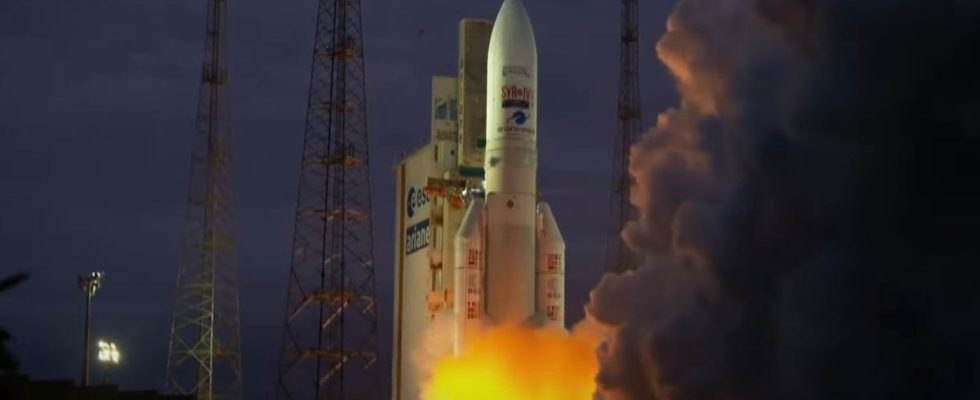Get out the tissues! For its final mission, the Ariane 5 rocket took off successfully Wednesday evening at 7:00 p.m. local time (midnight, in Paris) from the Guyana space center in Kourou, with two satellites on board, after two postponements of the launch. The French military communications satellite (Syracuse 4B) and the German experimental satellite separated from the launcher after about thirty minutes to be placed in orbit.
After 27 years of career and 117 launches, the European rocket bows out in a gloomy climate for space Europe, while waiting for Ariane 6 to take over, at the end of 2023 at best.
Difficult beginnings
This takeoff was “charged with emotion” for the teams of the Guiana Space Center (CSG), whose rocket has punctuated life for three decades, confides to AFP its director, Marie-Anne Clair. While crossing the huge European space base, his colleagues had a twinge in front of the Ariane 5 integration building, which was definitely empty.
Kourou’s flagship rocket had a difficult start: it exploded just after takeoff on its maiden flight in 1996. It suffered another and only bitter failure in 2002. A “trauma” that “marked us with a red iron”, remembers Hervé Gilibert, then architect of the launcher. “It took two years to return to flight,” says the current technical director of the ArianeGroup prime contractor.
Ariane 5 then entered its golden age, with a string of successes. The failures of the start had had “the virtuous effect of keeping us in absolute vigilance over the launches”, notes this engineer.
James Webb, the apotheosis
The rocket thus earned such a reputation for reliability that NASA entrusted it with sending its emblematic James Webb telescope, worth 10 billion dollars. This launch, on Christmas Day 2021, marked an apotheosis for the one who also sent the Rosetta probes to comet Tchouri (2004) and Juice to Jupiter (April 2023).
On the commercial level, it was “the spearhead of space Europe”, underlines Daniel Neuenschwander, director of space transport of the European space agency (ESA). Twelve countries took part in the manufacture of the heavy launcher which took over from Ariane 4, with a doubled launch capacity: a competitive advantage which has enabled Europe to impose itself on the communication satellite market.
The Old Continent also benefited from a “period of hollow” on the other side of the Atlantic, the American space shuttle “monopolizing a lot of resources”, recognizes Daniel Neuenschwander. “Today, he continues, we are experiencing exactly the opposite situation”, and Europe finds itself virtually deprived of independent access to space.
SpaceX dominance
At issue: the sudden end of the operation of Russian Soyuz rockets, following the Russian invasion of Ukraine in February 2022, which plunged the activity of the Kourou base from where only six shots are left in 2022, compared to 15 the previous year.
The failure of the first commercial launch of the Italian Vega C light launcher, in December 2022, and the cumulative delays for the future Ariane 6, have worsened the situation: after Friday, there will only be one Vega launch left in September, and a probable return to flight of Vega-C at the end of the year.
This means several months of emptiness while waiting for the Ariane 6 relay, at best at the end of 2023. More powerful and more competitive with costs halved compared to Ariane 5, Ariane 6 was designed to withstand the fierce competition on the market. launchers, dominated by the American SpaceX, in good health with more than one launch per week.
Vulcain engine tests in two weeks
ESA was forced to turn to Elon Musk’s company to launch its scientific mission Euclid, and is not sure of ensuring by itself the strategic deployment of the next Galileo satellites, the navigation system of the ‘European Union.
“It’s not an easy time, but it won’t last,” assured the president of Arianespace Stéphane Israel, during a meeting of the Ariane 6 team, under pressure to take off as quickly as possible. the order book is already full. Until then, the teams in Kourou “take their troubles patiently”, says the director of the CSG, who foresees a drop in staff of around 190 people out of 1,600.
The break is used for the plan of renovation and greening of the base. And the Ariane 6 qualification tests are in full swing: in two weeks, the Vulcain engine will be fired up on its launch pad, a major step impatiently awaited.

